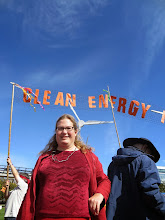Delta-Montrose Energy Association (DMEA) announced on Earth Day that its members had fully leased the capacity of its two 10,000-watt community solar arrays.
A total of 84 cooperative members joined the local power partnership, leasing portions of the arrays in $10 increments. More than half of the participants invested in the $10 to $100 range, 17 leases were up to $500 in value, and 11 were above $1,000. In sum, co-op members invested $75,000 to receive the benefits of solar-generated electricity without having to install panels on their own homes or businesses.
"We are excited by the members' enthusiastic response to this program," said Jim Heneghan, DMEA's renewable energy engineer and the Community Solar Array manager. "Local power production can help recharge our economy."
Within everyone's reach
Community solar arrays are a clever solution to the familiar barriers to installing solar panels. Consumers living in rental properties, homeowners who don't have good solar exposure or who are put off by system maintenance and repair are able to support solar power through solar "gardens." If members move within DMEA's territory, the monthly solar credit on their electric bill goes with them.
United Power in Brighton, Colo., and St. George, Utah, were early pioneers of the concept. "Our big innovation was to fractionalize the ownership so that it is affordable for everyone," said DMEA Public Relations Supervisor Tom Polikalas. "Reaching that affordability was really important to the general manager, staff and board of directors."
Members can lease a portion of the two 10-kilowatt photovoltaic solar electric arrays for as little as a one-time $10 payment. On their monthly bills, they receive a credit for the electricity their portion of the array produces for the 25-year term of the lease.
Each $10 block leased provides the subscriber with 2.67 watts of capacity in the array, or an estimated annual bill credit of about $ 0.50. DMEA's engineering staff calculated the arrays' production based on a $10 lease representing 2.67 watts of generating capacity:
(2.67 watts) x (6 hours sun/day) x (365 days/year) = 5,847 watt-hours per year
(5,847 watt-hours/year) x (1 kilowatt/1000 watts) = 5.847 kilowatt-hours/year
(5.8 kwh/year) x $0.09703/kwh) = $0.56 credit /year
"The 50-cent credit is an estimate, but the actual credit might be a little higher. DMEA doesn't guarantee a specific return," said Polikalas. "It will be interesting to see how the credit averages over the year."
Benefits for consumers
Since the price of energy generally moves in only one direction—up—the value of the solar array shares will likely increase as well. "It's a nice hedge against inflation," Polikalas added.
While leases start at just $10, members can lease as much capacity as they'd like whether that's $10 worth or $10,000 worth. Polikalas noted several examples of leases at different levels: $100 invested by Bright Beginnings, a private school in Montrose that will use its portion of the array for educational purposes; a $500 investment by Buckhorn Geotech, a local e-engineering firm that wanted to support renewable energy development. Two other individual members invested more than $10,000!
"Further up the road, I think DMEA would like to do a study to learn more about why members participate," he said. "Right now, we can really just speculate about the different motivations."
Local generation supports community economy
The cooperative is very clear on its own reasons for developing renewable energy. The solar arrays are the first project of DMEA's Local Power Partnership. The program aims to harness the abundant renewable energy resources of Colorado's Western Slope, while keeping energy dollars within the community.
A local company built the arrays, which cost about $92,000 and brought a grant from the Colorado Governor's Energy Office to the community. DMEA's board recently voted to fund the construction of two more 10,000-watt arrays, and expects to issue a request for proposals this summer. Ideally, the project will result in more work for local contractors.
DMEA's South Canal project offers the potential for even greater economic development, along with 6 MW of low-impact hydropower. The plan is to harness the power of water moving through a central channel of the irrigation network that serves the Uncompahgre Valley. This locally-developed, run-of-river facility would bring roughly $20 million in construction work to DMEA's territory and serve about 5 percent of its load with renewable energy.
While the Community Solar Arrays and the South Canal are the co-op's biggest renewable projects, Polikalas noted that DMEA is also looking at biomass opportunities in the area. "If you look at the logo for our Local Power Partnership program, you'll see that it is not uniquely solar," he said. "The Community Solar Arrays have been a great starting point for building our own local new energy economy."
DMEA continues to seek and evaluate other renewable energy development opportunities to benefit co-op members and the local community.
Joy Hughes, Founder, Solar Gardens Institute http://www.solargardens.org
CEO, Solar Panel Hosting LLC http://www.solarpanelhosting.com
(719)207-3097 direct


No comments:
Post a Comment